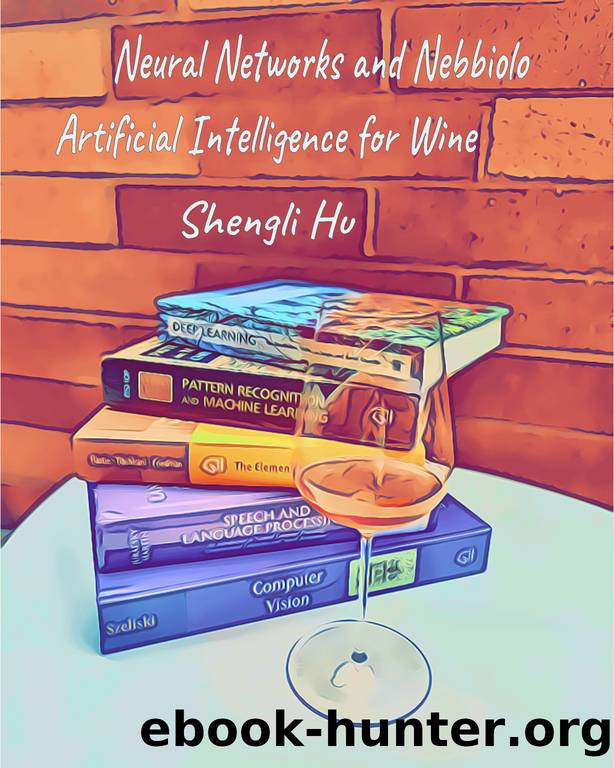Neural Networks and Nebbiolo: Artificial Intelligence for Wine by Hu Shengli

Author:Hu, Shengli [Hu, Shengli]
Language: eng
Format: epub
Publisher: Ciel d'Avril
Published: 2021-09-29T16:00:00+00:00
Figure 61: A photo-mosaic collage of sample images from iGrapevine for fine-grained image classification .
Figure 62: A photo-mosaic collage of sample images from VinePathology for fine-grained image classification .
For example, given an image of a grapevine in terms of leaves or clusters, besides training a fine-grained visual classification algorithm to recognize the grape variety, viticulturists are perhaps more interested in automatic assessment of vine age, vine health, potential pathology, current level of water stress, environmental information that could be derived from the grapevine image such as the soil type, or the macro-, meso-, and microclimate the vine is cultivated in, etc. Answering questions such as how effective learned representations learned for the classic fine-grained visual categorization problem could be used for attacking a myriad of downstream tasks, perhaps with the help of contrastive learning (Section 4.1 ) could indeed accelerate the adoption and penetration of state-of-the-art AI algorithms in various scientific domains such as viticulture or biodiversity. [Van Horn et al., 2021 ] presented one of the first few steps in such directions. And there exists many open problems in this exciting domain of finegrained image analysis yet to be addressed:
⢠Formal characterization of the problem: what exactly does âfine-grainedâ mean and how to define or disambiguate a potential definition of granularity?
⢠Data and label efficient approaches to fine-grained image analysis: how to design efficient approaches of targeted engagement with human expertise in mind?
⢠Self-supervision in the fine-grained setting: perhaps data augmentation (detailed in Section 7.1.1 ) could be leveraged for contrastive learning (see Section 4.1 );
⢠Going beyond static images: how should we incorporate multimodal datasets such as combining video clips and spectrogram data (or audio data in general)?
Some of these problems and their manifestations in viticulture and agriculture are indeed on our agenda for future work, hopefully to be published and introduced in future editions of this book.
8
Craft Cocktails
There appears no definite or universally acknowledged definition of cocktail, even though some define it as any drink made by mixing two or ingredients together. For instance, John deBart, a mixologist formerly at Please Donât Tell (PDT) and Momofuku in Manhattan, started off the topic with âthatâs right, coffee with milk and sugar, thatâs cocktail right there in your morning cup of joeâ in his hilarious book Drink What You Want.
A firm grasp of knowledge in cocktails, spirits, and mixology could pay good dividends at some point of oneâs career as a beverage professional, a. It may as well involve learning classic cocktail recipes by heart (how to make The Last Word?), understanding the making as well as the flavor profiles of each and every ingredient (what is Drambuie made of?), and perhaps being able to explain the history, cultural references, and tales around iconic creations like Sazerac or Vesper. As a sommelier or beverage director gets more involved in putting together a beverage program, one might start experimenting with new alcoholic concoctions that best suit the restaurant, the consumer base, or even the occasion. Such begs the questions, how
Download
This site does not store any files on its server. We only index and link to content provided by other sites. Please contact the content providers to delete copyright contents if any and email us, we'll remove relevant links or contents immediately.
Algorithms of the Intelligent Web by Haralambos Marmanis;Dmitry Babenko(7852)
Hadoop in Practice by Alex Holmes(5660)
Jquery UI in Action : Master the concepts Of Jquery UI: A Step By Step Approach by ANMOL GOYAL(5512)
Life 3.0: Being Human in the Age of Artificial Intelligence by Tegmark Max(4507)
Functional Programming in JavaScript by Mantyla Dan(3723)
The Age of Surveillance Capitalism by Shoshana Zuboff(3422)
Big Data Analysis with Python by Ivan Marin(3009)
Blockchain Basics by Daniel Drescher(2891)
The Rosie Effect by Graeme Simsion(2708)
WordPress Plugin Development Cookbook by Yannick Lefebvre(2602)
Hands-On Machine Learning for Algorithmic Trading by Stefan Jansen(2518)
Applied Predictive Modeling by Max Kuhn & Kjell Johnson(2478)
Dawn of the New Everything by Jaron Lanier(2438)
Test-Driven Development with Java by Alan Mellor(2378)
The Art Of Deception by Kevin Mitnick(2297)
Data Augmentation with Python by Duc Haba(2224)
Rapid Viz: A New Method for the Rapid Visualization of Ideas by Kurt Hanks & Larry Belliston(2195)
Human Dynamics Research in Smart and Connected Communities by Shih-Lung Shaw & Daniel Sui(2178)
The Infinite Retina by Robert Scoble Irena Cronin(2175)
